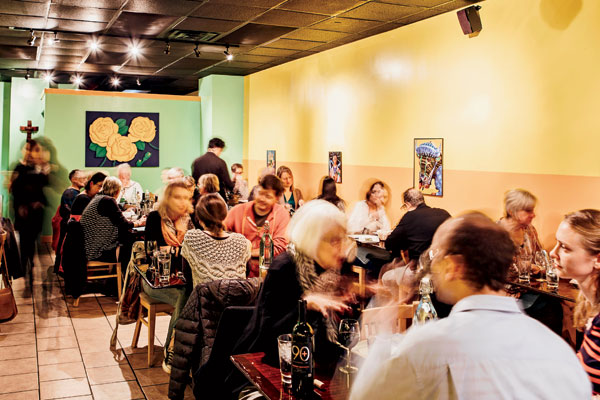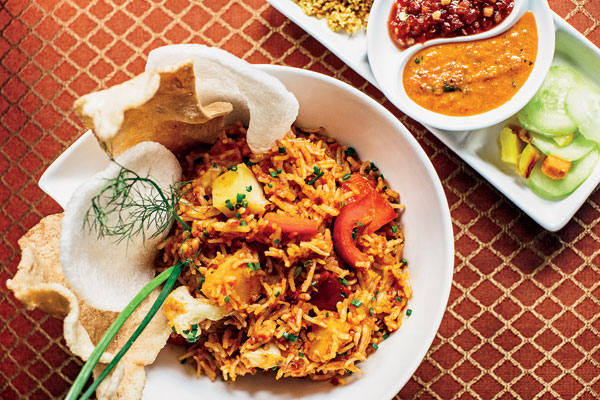Lately, I wonder if I am slipping into that odious stage of a food writer’s career where nothing seems as good as it once was. Every restaurant has gotten too loud, every waiter too chummy; the chefs are presumptuous, and the prices preposterous. I call it the Get the Hell Off My Plate phase.
Then places like De Quay and Ixcateco Grill come along, and I’m reborn. Sincere, affordable neighborhood restaurants where chefs follow their hearts, free to uphold traditions without letting their egos blind them? Yes. And just like that, the high horse waiting for me to saddle up is forced to tap its hoof while I applaud.
The storefront at 2470 North Lincoln Avenue has pickled the livers of God knows how many 20-somethings over the years as Lucille’s, the Toasted Ox, and Dillinger’s. As De Quay (since May), it has the brown wood and mellow bonhomie of an Amsterdam café. Led by Terry McNeese, the congenial GM, its earnest and understated staffers give the impression they’ve always been there. The food, by half-Dutch chef-owner David de Quay, feels new and fresh.
Dutch cuisine, consisting generally of blunt dishes with impenetrable names, such as zuurkoolstamppot (sauerkraut) and snert (split pea soup), practically sets itself up for Americans to overlook. But De Quay takes on Dutch-Indonesian cuisine—a colonial mash-up that few in Chicago know—and makes it impossible to ignore, let alone dislike. The focused menu marries lush Eastern spices with simple Western largess and calls it “comfort food,” a bit of false modesty considering De Quay’s idea of rib-sticking fare is a stunning braised beef short rib with shiitake and red wine sauce and a croquette filled with ultrathick beef rendang curry. Potential throwaways turn into lovely proposals: See the crisp, vinegary dumplings oozing nutty Gouda, bacon, and English peas.
Even dishes that seem simple and universal, such as chicken satay, are the result of endless research. “During my travels, chefs told me that every island in Indonesia has a different version of satay,” says De Quay. He combines two recipes—a slightly sweet one from the island of Madura and a basic (read: spicier) satay Manis—into a single concoction, marinating the chicken overnight in sweet soy, shallots, garlic, chili peppers, ginger, and turmeric. Sides of spicy, brown-sugary peanut sauce and crisp Dutch coleslaw are both memorable, but unnecessary; the chicken is that special.
The East-West union creates unforgettable triumphs such as a heap of steamed mussels with Balinese curry seeping into every shell, zapping each bivalve with rich coconut flavor. I kept using the cassava and shrimp krupuks (deep-fried Indonesian crackers) to scoop up the fleshy mussels, and baguette slices to soak up the sauce. Nasi goreng, a beloved stir-fried rice dish, is a classic fridge-blitz breakfast in Indonesia and the Netherlands. On North Lincoln Avenue, it’s a corn-studded appetizer with fun dipping options: the kick of chili sambal, the punch of pickled cucumber, or the massage of coconut serundeng. Your choice.
I adored the eye-catching presentations, particularly the glorious grilled pork chop and rookworst (Dutch smoked sausage) with braised savoy cabbage and fried kale lounging in a striking pan sauce with thyme and Groningen mustard. But my favorite dish was the biggest mess visually. The impeccable grilled North Sea salmon, surrounded by red and green heirloom tomatoes, sweet corn, and coconut-pandan rice, poked with fried lotus roots and stained by shrimp sambal, looks like a painter’s palette that fell in a river. I closed my eyes, and it was amazing.
About the only shaky brushstrokes in my meals were the thick oorlog Amsterdam frites that tasted as if they had been born in old oil, and a skeezy undercooked duck leg that all the tamarind and caramelized fennel in the world couldn’t have unskeezed. For desserts, the chef sticks with sure things, such as a Dutch chocolate and peanut butter pavé and an irresistible housemade stroopwafel, two thin waffle cookies sandwiching a stratum of understated brown sugar syrup. As for drinks, De Quay’s cocktails bat about .500. I put more trust in McNeese’s suggestions from the small but savvy wine list.
It’s a good sign when a restaurant makes you want to go to the country whose cuisine it proffers. Chicago is only 4,100 miles from Holland; from there, just another 7,000 to Indonesia. That seems doable and, if De Quay is any indication, completely worthwhile.

A similar spirit flows through Ixcateco Grill, a lovable four-month-old joint in Albany Park. The 44-seat BYO can’t hide its Frontera Grill influence: Chef-owner Anselmo Ramirez, a native of the Mexican state of Guerrero, spent 13 years in Rick Bayless’s legendary kitchens, and he’s got the kind of confidence that Bayless pupils always seem to absorb. Ramirez’s young staff internalizes that enthusiasm and distributes it to every table.
But instead of trying to cover the enormous ground that Frontera does, Ixcateco goes in the other direction, focusing on just 10 dishes at a time. And it gets all 10 of them right. There’s nothing new about Ixcateco’s tilapia ceviche—nor is there anything wrong with it, especially when the plump chunks of fish glisten with lime and mingle with serrano chilies, tomatillos, tomatoes, and celery. And we’ve all seen plenty of guacamole in our time, even the good chunky stuff served on a banana leaf, but rarely is it completed with lemon-tinged homemade tortilla chips like Ramirez’s. Usually any attempt to fancify or improve upon these time-tested dishes only weakens them and diminishes the person who tries.
Crucial to a southern Mexican restaurant is the wood grill, and Ramirez has mastered it. His carne asada, instead of devolving into the punishing chewfest that so many do, gets marinated in adobo and grilled into medium-rare submission, then served with a lovely tomato molcajete sauce and queso-topped black beans. He works that same adobo marinade and wood grill to great effect with a crisp-edged pork loin, which lands on a mound of whippy sweet potatoes with a moody pasilla, tomato, and mezcal sauce. It’s good on its own; stuffed into one of the warm tortillas made by Ramirez’s mother, it’s downright heroic. You might find yourself wanting to cram grilled camarónes into the tortillas, layer in oyster mushrooms and epazote, and slather them with thick tomato cream sauce. Do not ignore this impulse.
That ramekin of homemade mango sorbet will not cool you off. The kitchen flavors it with chilies, the heat lingering on your tongue long after the meal ends as a reminder that you’ve experienced simple, unadorned pleasure. The BYO policy is here to stay and, on my visits, unpolished—our prompt, baby-faced server had to fetch a food runner to open our beers. But the eager service somehow seems perfect for the underdecorated, brightly colored storefront. The entire staff puts all its energy into making and honoring Ixcateco’s lively food, and that’s more than enough, even for a snarky old grump like me.



